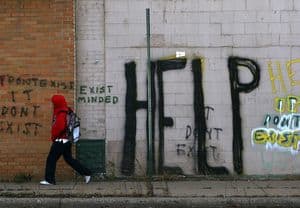
The data comes via a poll released by the Associated Press over the weekend, which points to "the widening gap between rich and poor, and the loss of good-paying manufacturing jobs as reasons for the trend."
The economic indicator, officially dubbed "economic insecurity", defines the criteria as those adults who have experienced unemployment at any point during their careers, spent a year or more relying on government assistance such as food stamps, or having an income at least 150% below the poverty line. According to Huffington Post, "measured across all races, the risk of economic insecurity rises to 79 percent." The study also marked a closing of gaps between whites and nonwhites with regard to poverty rates when compared to census data from the 1970s. It also showed:
"Marriage rates are in decline across all races, and the number of white mother-headed households living in poverty has risen to the level of black ones."
The study also remarks on the creation of "the invisible poor", which is a term used to describe those living in suburbs or rural towns who fall into the category of experiencing "economic insecurity".
"Concentrated in Appalachia in the East, they are numerous in the industrial Midwest and spread across America's heartland, from Missouri, Arkansas and Oklahoma up through the Great Plains."
 These invisible poor, who, more often than not, tend to be white, are less likely to be targeted by programs seeking to aid other impoverished groups in other, more urban areas. This could be one of the contributing factors to why racial gaps are closing. Mark Rank, a professor at Washington University in St. Louis, told the Huffington Post:
These invisible poor, who, more often than not, tend to be white, are less likely to be targeted by programs seeking to aid other impoverished groups in other, more urban areas. This could be one of the contributing factors to why racial gaps are closing. Mark Rank, a professor at Washington University in St. Louis, told the Huffington Post:
"Poverty is no longer an issue of `them', it's an issue of `us'…Only when poverty is thought of as a mainstream event, rather than a fringe experience that just affects blacks and Hispanics, can we really begin to build broader support for programs that lift people in need."
Other noteworthy findings include:
- "For the first time since 1975, the number of white single-mother households living in poverty with children surpassed or equaled black ones in the past decade, spurred by job losses and faster rates of out-of-wedlock births among whites. White single-mother families in poverty stood at nearly 1.5 million in 2011, comparable to the number for blacks. Hispanic single-mother families in poverty trailed at 1.2 million."
- "Since 2000, the poverty rate among working-class whites has grown faster than among working-class nonwhites, rising 3 percentage points to 11 percent as the recession took a bigger toll among lower-wage workers. Still, poverty among working-class nonwhites remains higher, at 23 percent."
- "The share of children living in high-poverty neighborhoods – those with poverty rates of 30 percent or more – has increased to 1 in 10, putting them at higher risk of teenage pregnancy or dropping out of school. Non-Hispanic whites accounted for 17 percent of the child population in such neighborhoods, compared with 13 percent in 2000, even though the overall proportion of white children in the U.S. has been declining."
- "The share of black children in high-poverty neighborhoods dropped from 43 percent to 37 percent, while the share of Latino children went from 38 percent to 39 percent."
- "Race disparities in health and education have narrowed generally since the 1960s. While residential segregation remains high, a typical black person now lives in a nonmajority black neighborhood for the first time. Previous studies have shown that wealth is a greater predictor of standardized test scores than race; the test-score gap between rich and low-income students is now nearly double the gap between blacks and whites."
Thus, while the economy has reportedly finished its recession from late last decade, it does not appear to be growing fast enough to sustain the record 46.2 million people reportedly living in poverty.



